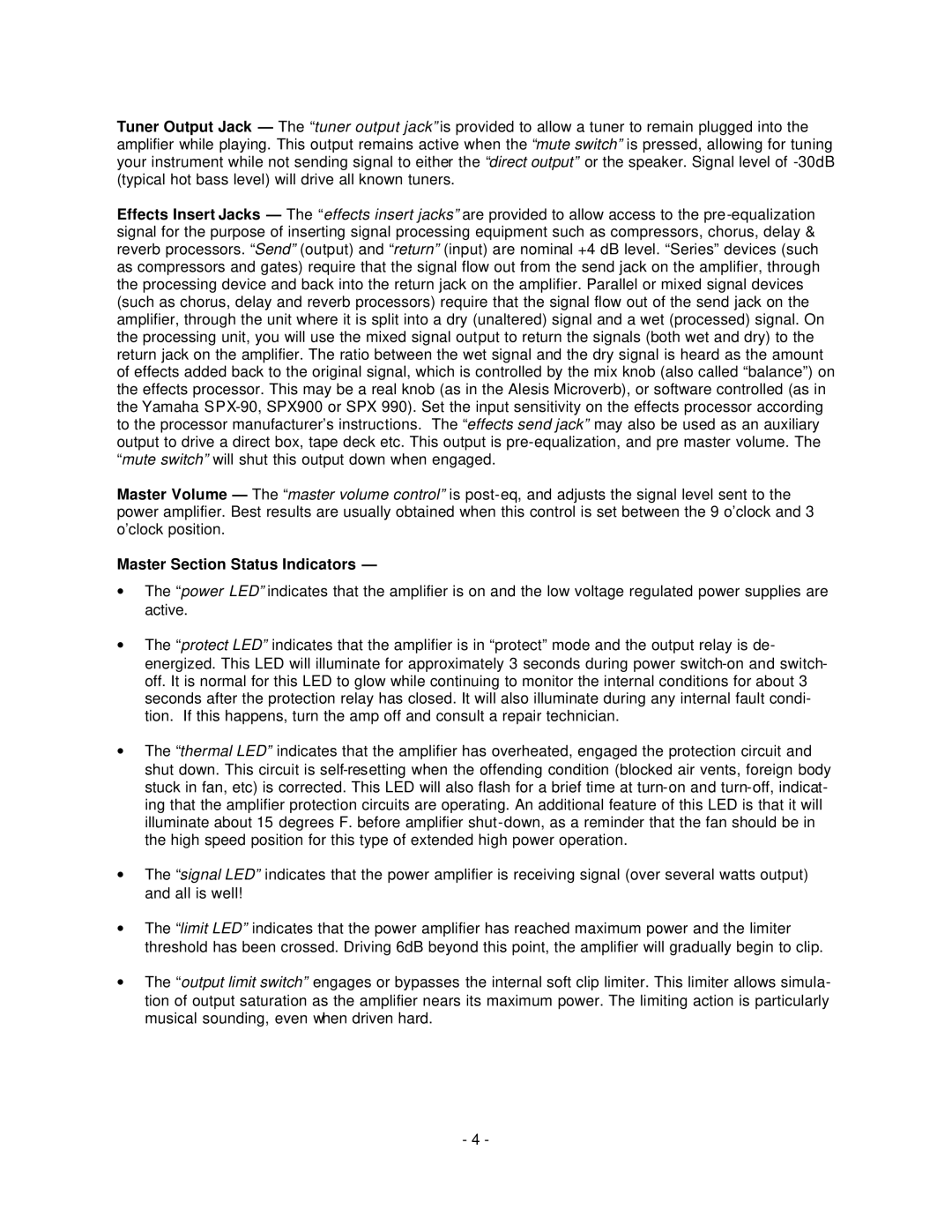Tuner Output Jack — The “tuner output jack” is provided to allow a tuner to remain plugged into the amplifier while playing. This output remains active when the “mute switch” is pressed, allowing for tuning your instrument while not sending signal to either the “direct output” or the speaker. Signal level of -30dB (typical hot bass level) will drive all known tuners.
Effects Insert Jacks — The “effects insert jacks” are provided to allow access to the pre-equalization signal for the purpose of inserting signal processing equipment such as compressors, chorus, delay & reverb processors. “Send” (output) and “return” (input) are nominal +4 dB level. “Series” devices (such as compressors and gates) require that the signal flow out from the send jack on the amplifier, through the processing device and back into the return jack on the amplifier. Parallel or mixed signal devices (such as chorus, delay and reverb processors) require that the signal flow out of the send jack on the amplifier, through the unit where it is split into a dry (unaltered) signal and a wet (processed) signal. On the processing unit, you will use the mixed signal output to return the signals (both wet and dry) to the return jack on the amplifier. The ratio between the wet signal and the dry signal is heard as the amount of effects added back to the original signal, which is controlled by the mix knob (also called “balance”) on the effects processor. This may be a real knob (as in the Alesis Microverb), or software controlled (as in the Yamaha SPX-90, SPX900 or SPX 990). Set the input sensitivity on the effects processor according to the processor manufacturer’s instructions. The “effects send jack” may also be used as an auxiliary output to drive a direct box, tape deck etc. This output is pre-equalization, and pre master volume. The “mute switch” will shut this output down when engaged.
Master Volume — The “master volume control” is post-eq, and adjusts the signal level sent to the power amplifier. Best results are usually obtained when this control is set between the 9 o’clock and 3 o’clock position.
Master Section Status Indicators —
∙The “power LED” indicates that the amplifier is on and the low voltage regulated power supplies are active.
∙The “protect LED” indicates that the amplifier is in “protect” mode and the output relay is de- energized. This LED will illuminate for approximately 3 seconds during power switch-on and switch- off. It is normal for this LED to glow while continuing to monitor the internal conditions for about 3 seconds after the protection relay has closed. It will also illuminate during any internal fault condi- tion. If this happens, turn the amp off and consult a repair technician.
∙The “thermal LED” indicates that the amplifier has overheated, engaged the protection circuit and shut down. This circuit is self-resetting when the offending condition (blocked air vents, foreign body stuck in fan, etc) is corrected. This LED will also flash for a brief time at turn-on and turn-off, indicat- ing that the amplifier protection circuits are operating. An additional feature of this LED is that it will illuminate about 15 degrees F. before amplifier shut-down, as a reminder that the fan should be in the high speed position for this type of extended high power operation.
∙The “signal LED” indicates that the power amplifier is receiving signal (over several watts output) and all is well!
∙The “limit LED” indicates that the power amplifier has reached maximum power and the limiter threshold has been crossed. Driving 6dB beyond this point, the amplifier will gradually begin to clip.
∙The “output limit switch” engages or bypasses the internal soft clip limiter. This limiter allows simula- tion of output saturation as the amplifier nears its maximum power. The limiting action is particularly musical sounding, even when driven hard.
